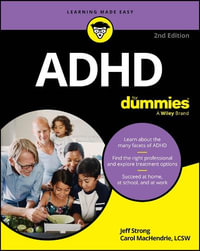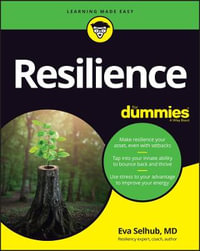
At a Glance
368 Pages
23 x 18.5 x 2.5
New Edition
Paperback
Limited Stock Available
RRP $46.15
$32.80
29%OFF
or 4 interest-free payments of $8.20 with
orWhen will this arrive by?
According to the National Institutes of Health, an estimated five to ten percent of children suffer from Attention Deficit Disorder (ADD) or Attention Deficit Hyperactivity Disorder (ADHD). This book provides answers for parents of children who may have either condition, as well as for adult sufferers. Written in a friendly, easy-to-understand style, it helps people recognize and understand ADD and ADHD symptoms and offers an authoritative, balanced overview of both drug and non-drug therapies.
About The Authors
Jeff Strong (Lamy, NM), an adult living with ADD, is President of the REI Institute, a music-medicine research center focusing on people with neuro-developmental disabilities, including those with ADD/ADHD.
Michael O. Flanagan, MD (Lamy, NM), is the director of several ADD clinics in New Mexico.
Introduction 1
About This Book 1
Not So Foolish Assumptions 2
Conventions Used in This Book 2
How This Book Is Organized 3
Part I: The ABCs of AD/HD 3
Part II: Diagnosing AD/HD 3
Part III: Treating AD/HD 3
Part IV: Living with AD/HD 4
Part V: The Part of Tens 4
Icons Used in This Book 4
Where to Go from Here 5
Part I: The ABCs of AD/HD 7
Chapter 1: AD/HD Basics 9
Identifying Symptoms of AD/HD 10
Peering into primary symptoms 10
Seeing a few secondary symptoms 11
Clueing in on AD/HD’s Origins 11
Getting a Diagnosis of AD/HD 12
Choosing your professional 12
Preparing for the evaluation process 13
Viewing Various Treatment Approaches 14
Recognizing AD/HD’s Role in Your Life 14
Dealing with daily life 15
Accentuating the positive 15
Chapter 2: Exploring the Causes of AD/HD 17
Reviewing Past Theories 17
Searching for a Plausible Theory 20
Examining the Core Issue in AD/HD 21
Recognizing the role of self-regulation 21
Exploring executive functions 22
Exploring Current AD/HD Research 24
Genetic 24
Anatomical 25
Functional 26
Chemical 27
Getting Down to the Bottom Line 29
Chapter 3: The Many Faces of AD/HD 31
Picturing the Primary Symptoms of AD/HD 31
Inattention/distractibility 32
Impulsivity 34
Restlessness/hyperactivity 36
Studying Some Secondary Symptoms 37
Anticipation of failure 37
Worry 38
Boredom 38
Loss of motivation/feelings of hopelessness 38
Frustration 39
Low self-esteem 39
Sleep disturbances 39
Substance abuse 40
Facing AD/HD in Different Populations 40
Children 41
Adolescents 41
Adults 42
Women 43
Part II: Diagnosing AD/HD 45
Chapter 4: Finding the Right Professional for You 47
Help Wanted: Searching for the Right Person(s) 47
Getting a diagnosis for legal purposes 48
Considering your professional options 48
Examining Your Values 55
Digging into your ideas about diagnosis 56
Tackling your thoughts on treatment 56
Evaluating Your AD/HD Professional 57
Selecting a diagnostician 57
Partnering up for treatment 58
Getting a Second Opinion 59
Managing Your Care 60
Being Eligible for Services 61
Examining your insurance coverage 62
Seeking out school services 62
Chapter 5: Navigating the Evaluation Process 65
Preparing for the Evaluation Process 65
Psychiatric/Psychological Evaluations 67
Medical Testing 68
Educational Testing 69
Skills Testing 70
Behavioral Assessment 71
Performance Testing 71
Physiological Testing 72
EEG 72
ERP 72
MRI 73
fMRI 73
PET 73
SPECT 74
Knowing What to Do after Diagnosis 74
Chapter 6: Conditions That Look Like or Overlap with AD/HD 77
Understanding Differential Diagnosis 77
Looking at Conditions with Symptoms Similar to AD/HD 79
Mental disorders 79
Medical conditions 84
Sensory processing disorders 86
Pseudo-AD/HD 88
Part III: Treating AD/HD 91
Chapter 7: Choosing the Best Treatment Options for You 93
Understanding the Three Levels of Treatment 93
Biological treatments 94
Psychological treatments 95
Social treatments 97
Trying Multiple Treatments Together 99
Developing Your Plan for Success 99
Naming your challenges 100
Identifying your goals 101
Sifting through the options 101
Prioritizing your plan 102
Combining approaches safely 102
Following Your Progress 103
Keeping Up-to-Date on New Therapies 104
Attending conferences 105
Browsing the Internet 106
Reading professional journal articles 106
Attending support group meetings 107
Chapter 8: Managing Medication 109
Determining If Medication Is Right for You 109
Understanding How Medications Work 110
Recognizing medication’s impact on brain chemicals 110
Connecting symptoms and brain chemicals 111
Exploring Medication Types 112
Stimulants 112
Non-stimulant AD/HD medication 113
Monoamine oxidase inhibitors (MAOIs) 113
Selective serotonin reuptake inhibitors (SSRIs) 113
Serotonin/norepinephrine reuptake inhibitors 114
Tricyclic antidepressants (TCAs) 115
Atypical antidepressant agents 116
Dopamine agonists 116
Antihypertensives 116
Anticonvulsants 117
One more for the road 117
Finding Success with Medication 118
Recognizing positive results 118
Singling out side effects 120
Charting your progress 122
Knowing when to call it quits 122
Chapter 9: Queuing Up Counseling, Coaching, and Training 125
Adding Counseling to Your Treatment Plan 125
Exploring Counseling and Therapy Options 127
Understanding yourself through insight-oriented therapy 127
Benefiting from supportive therapy 129
Considering cognitive-behavioral counseling 129
Exploring behavior modification 131
Expressing yourself through play therapy 131
Seeking psychoeducational counseling 131
Considering family therapy 132
Getting into group therapy 132
Using support groups 133
Considering Coaching 134
Taking a Look at Training 135
Examining awareness training 135
Taking parent training 135
Improving yourself through skills training 136
Finding a Counselor, Coach, or Trainer 136
Chapter 10: Managing Behavior 139
Taking Behavior 101 139
Association 140
Feed forward/feedback 140
The basics of behavioral therapies 141
Looking at Behavioral Treatments 142
Behavior modification 142
Cognitive-behavioral counseling 145
Awareness training 148
Chapter 11: Narrowing In on Nutrition, Vitamins, and Herbs 151
Digging Into a Healthy Diet 152
Defining healthy eating habits 152
Figuring out the Feingold diet 159
Viewing Vitamin and Herb Supplements 162
Singling out supportive supplements 163
Surveying specific supplements 166
Knowing about Nutraceuticals 168
Protecting Your Environment 168
Allergens 169
Chemicals 172
Chapter 12: Examining Repatterning Therapies 175
Altering Brain Activity Through Neurofeedback 176
Getting some background 176
Exploring the process 177
Knowing what to expect 178
Finding a provider 179
Using Rhythm to Stimulate the Nervous System 179
Getting some background 179
Exploring the process 180
Knowing what to expect 181
Finding a provider 182
Changing the Way You Hear Sound 182
Getting some background 182
Exploring the process 183
Knowing what to expect 184
Finding a provider 185
Exercising Your Eyes 186
Getting some background 186
Exploring the process 187
Knowing what to expect 187
Finding a provider 188
Chapter 13: Recognizing Rebalancing Therapies 189
Balancing Energy Through Acupuncture 189
Getting some background 190
Exploring the process 190
Knowing what to expect 191
Finding a provider 191
Helping Your Body Heal Itself with Homeopathy 192
Getting some background 192
Exploring the process 192
Knowing what to expect 193
Finding a provider 193
Using Manipulation Therapies 194
Getting some background 194
Exploring the process 195
Knowing what to expect 195
Finding a provider 196
Helping Your Brain Process Sensory Information 196
Getting some background 196
Exploring the process 197
Knowing what to expect 198
Finding a provider 198
Part IV: Living with AD/HD 199
Chapter 14: Creating Harmony at Home 201
Laying the Foundation for Healthy Relationships 201
Exercising empathy 202
Expressing emotions 203
Commanding communication 204
Acknowledging appreciation 205
Canceling conflict 205
Healing the past 206
Being realistic 206
Improving Your Life with AD/HD 207
Managing moods 207
Taking responsibility 208
Parenting a Child with AD/HD 209
Preventing problems 209
Dealing with discipline 216
Raising more than one child 219
Enhancing self-esteem 221
Parenting as a team 222
Living with an Adult with AD/HD 223
Getting informed 223
Working together 223
Staying close 224
Taking time for yourself 224
Getting Into Good Habits 224
Becoming organized 225
Exercising regularly 226
Limiting TV and video games 227
Ensuring the best sleep possible 228
Providing play and fun 229
Chapter 15: Creating Success at School 231
Overcoming Challenges at Any Age 231
Addressing elementary school issues 232
Managing middle school difficulties 233
Handling high school challenges 235
Cluing into college challenges 236
Getting to Know Your Legal Rights 237
Having realistic expectations 238
Examining IDEA 238
Utilizing Section 504 240
Accessing an Educational Plan 241
Understanding what an educational plan is 241
Getting involved 242
Developing an accurate plan 242
Keeping tabs on the progress 243
Getting the Most from Your Child’s Teachers 243
Looking for the right teacher 245
Working with your child’s teacher 246
Documenting Your School Experiences 247
Exploring Schooling Alternatives 249
Dealing with Difficult Times in School 251
Lunchtime and recess 251
Transitions 252
Opportunities for socialization 252
Interactions with some teachers and administrators 254
Working with Your Child at Home 255
Helping with homework 255
Arranging for a private tutor 256
Supporting self-esteem 257
Helping your child stay organized 258
Chapter 16: Winning at Work 259
Understanding the Challenges at Work 259
To Tell or Not to Tell 260
Legally speaking: Understanding your rights 261
Practically speaking: Making your decision 262
Managing Yourself 263
Working on Work Relationships 264
Having a hand on the pulse of office politics 264
Dealing with authority 265
Getting along with coworkers 266
Being the boss 266
Doing Day-to-Day Tasks 268
Getting organized 268
Managing your time 269
Handling projects 270
Staying focused 271
Dealing with details 272
Creating Overall Success 272
Finding the best career for you 272
Looking at long-term plans 273
Making do at your current job 274
Understanding your value 274
Striking a balance 275
Going It Alone: Being Self-Employed 276
Chapter 17: Accentuating the Positive 279
Seeing the Positive in Your Symptoms 279
Examining Areas of Aptitude 280
Capitalizing on creativity 281
Capturing chaos 282
Accessing energy 282
Recognizing your risk-taking nature 283
Supporting your desire for independence 283
Exploring ambition 284
Involving intuition 284
Examining adaptability 285
Assessing athleticism 286
Finding and Nurturing the Areas Where You Excel 286
Part V: The Part of Tens 289
Chapter 18: Ten (or So) Tips to Organize Your Life 291
Getting Your Thoughts Organized 291
Recording information 292
Writing down ideas and appointments 292
Using a PDA 292
Organizing Your Time 293
Employing technology 293
Charting your schedule 294
Planning ahead 294
Completing Your Projects 295
Breaking things down 295
Making a plan 296
Taking one step at a time 296
Making Sense of Your Space 297
Cutting clutter off at the source 297
Putting things in their place 298
Creating a color-coding system 298
Deciding What’s Really Important to You 299
Chapter 19: Ten (or So) Ways to Improve Your Family Relationships 301
Taking Responsibility 301
Focusing on the Positive 302
Releasing Anger and Resentment 302
Getting Rid of Guilt 303
Talking It Out 303
Working Together 304
Having Family Meetings 304
Being Realistic 305
Having Fun Together 305
Walking Away 305
Taking Care of Yourself 306
Chapter 20: Ten Resources for Information and Support 307
Internet Forums 307
Web Sites 308
Support Groups 309
Your Child’s School 309
Colleges and Universities 309
Your AD/HD Professional 310
Books 310
The Library 311
Family and Friends 311
Group Therapy 311
Appendix: Treatment Tracking Forms 313
Keeping Daily Tabs on Your Treatment 313
Performing Periodic Assessments 314
Index 319
ISBN: 9780764537127
ISBN-10: 0764537121
Series: For Dummies
Published: 15th October 2004
Format: Paperback
Language: English
Number of Pages: 368
Audience: General Adult
Publisher: John Wiley & Sons Inc (US)
Country of Publication: US
Edition Number: 1
Dimensions (cm): 23 x 18.5 x 2.5
Weight (kg): 0.78
Shipping
| Standard Shipping | Express Shipping | |
|---|---|---|
| Metro postcodes: | $9.99 | $14.95 |
| Regional postcodes: | $9.99 | $14.95 |
| Rural postcodes: | $9.99 | $14.95 |
How to return your order
At Booktopia, we offer hassle-free returns in accordance with our returns policy. If you wish to return an item, please get in touch with Booktopia Customer Care.
Additional postage charges may be applicable.
Defective items
If there is a problem with any of the items received for your order then the Booktopia Customer Care team is ready to assist you.
For more info please visit our Help Centre.
You Can Find This Book In
This product is categorised by
- Non-FictionPsychologyPhysiological & Neuro-Psychology, Biopsychology
- Non-FictionFamily & HealthParenting: Advice & Issues
- Kids & Children's BooksPersonal & Social IssuesDisability, Impairments & Special Needs for Children & Teenagers
- Non-FictionSelf-Help, Personal Development & Practical AdviceHow-toFor Dummies BooksHumanities Psychology Reference
- Non-FictionSelf-Help, Personal Development & Practical AdviceHow-toFor Dummies BooksHealth Parenting & Education Reference
- BargainsNon-Fiction BargainsFamily & Relationships Bargains
- BargainsNon-Fiction BargainsBusiness, Finance & Self Help
- BargainsKids and Teens Bargains
























